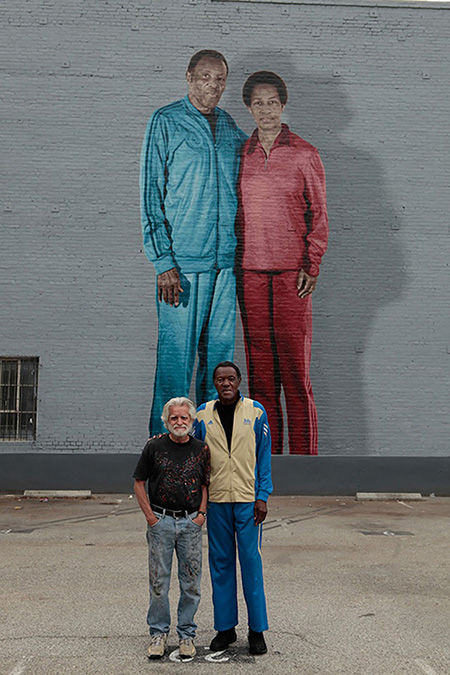
In February of 2015 I spent the afternoon with Rafer Johnson, the 1960 Decathlon Gold Medalist who passed away at age 86 on December 2nd. I co-produced a series of murals for the Special Olympics, which were to be held in Los Angeles that summer, and we convened at artist Kent Twitchell’s downtown L.A. studio for a photo shoot that would inspire the finished mural. Johnson had a long-time affiliation with the Special Olympics, having co-founded it’s California branch (with Eunice Shriver) in 1969 and served as its president for a number of years. Of course, by 2015 he was 80 years old, retired and shy of much public engagement. A San Fernando Valley resident, he told me that he much preferred the company of his grandchildren.
Our idea was to pair him with Loretta Claiborne, who is regarded as the finest athlete that Special Olympics has ever produced. No, this is not the same thing as the Olympic Games; the Special Olympics features people with physical and intellectual disabilities. Claiborne was born with clubbed feet, could not so much as walk until the age of four, but by age 17 she started earning medals as a runner. Very few among us could compete, athletically, with this woman and, given my tiny slice of Rafer Johnson’s story, if I have something to share about him, it is inextricably bound up with her. So I want you to remember Johnson; but please, also, to get to know Claiborne. They are spiritual twins. Twitchell’s mural is a binary tale of the overcoming of odds to achieve excellence on the field of play, and doing so with grace. Unfortunately, the downtown building was torn down in the course of redevelopment, but the mural was removed and is currently in storage. I plan to help Twitchell find a permanent home for it after I file this article; at least, I have some ideas.
Johnson was born in the segregated South in 1934, his family relocating to California in 1943. By his account he had become aware of the oppression of Black people at age nine, and his family was racially singular in the San Joaquin Valley town of Kingsburg. He grew up picking cotton after school (he hated it). Sports not only saved him, they made him popular and he blossomed. He began winning decathlons in high school (1952) as well as student body elections, where he served as his class at student body president. By 1956, just four years later, he won the Olympic Silver Medal at the Melbourne Games, followed by the legendary Gold Medal in the Rome Games of 1960 by an eyelash against his UCLA teammate CK Yang. Johnson told me that he considered him his closest personal friend until Yang’s death in 2007.
Johnson pursued a successful acting and broadcasting career for many years, but was also a political activist who worked on Robert F. Kennedy’s 1968 Presidential campaign. I listened to his impressions of the assassination at the Ambassador Hotel (today the Robert F. Kennedy School), where he and L.A. Rams player Roosevelt Grier tackled the Senator’s killer. Much later, Johnson was designated as the final bearer of the Olympic Torch opening the 1984 Los Angeles Games at the peristyle end of the Coliseum. He climbed a very long stairway to a platform from which he had to reach high to ignite the Coliseum’s torch. Imagine running, not walking, up several flights of stairs without a handrail, knowing that the eyes of hundreds of millions are upon you. If you look carefully you will see a handrail at the top of that platform. Initially Johnson was asked to complete his task without that handrail because it would look better on TV. He shared with me that looking down from that height after climbing the stairs and then extending himself to light the torch he could imagine plunging to his death to open the Games. Not such a great look. “That top step was wobbly, and I got my handrail,” he told me.
Looking at some of the images of these two remarkable souls, Johnson and Claiborne, I see a balm for our time, the response to a side of our culture that seeks to win at the cost of others, that regards the victory of an opponent as inherently illegitimate or a form of self-negation. Both became winners against all odds, but also suffered defeats and setbacks. In dealing with those they not only sought to improve themselves, but embraced and supported their competitors rather than vilifying them. Sportsmanship: What a concept. Therein lies Johnson’s enduring lesson for all of us.
